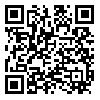

Volume 18, Issue 3 (11-2020)
RBS 2020, 18(3): 426-438 |
Back to browse issues page
Download citation:
BibTeX | RIS | EndNote | Medlars | ProCite | Reference Manager | RefWorks
Send citation to:



BibTeX | RIS | EndNote | Medlars | ProCite | Reference Manager | RefWorks
Send citation to:
Yousef Vatankhah A, Nejati V, Farahani H, Khaki M. Determination of six expressive postural positions for basic emotional states. RBS 2020; 18 (3) :426-438
URL: http://rbs.mui.ac.ir/article-1-739-en.html
URL: http://rbs.mui.ac.ir/article-1-739-en.html
1- M.A. in Acting, Department of Directing and Acting, Faculty of Art and Architecture, Tarbiat Modares University, Tehran, Iran. , ali.vatankhah@modares.ac.ir
2- Associate Professor, Department of Clinical Psychology and Health, School of Psychology and Education, Shahid Beheshti University, Tehran, Iran.
3- Assistant Professor, Department of Psychology, Faculty of Humanities, Tarbiat Modares University, Tehran, Iran.
4- Associate Professor, Department of Directing and Acting, Faculty of Art and Architecture, Tarbiat Modares University, Tehran, Iran.
2- Associate Professor, Department of Clinical Psychology and Health, School of Psychology and Education, Shahid Beheshti University, Tehran, Iran.
3- Assistant Professor, Department of Psychology, Faculty of Humanities, Tarbiat Modares University, Tehran, Iran.
4- Associate Professor, Department of Directing and Acting, Faculty of Art and Architecture, Tarbiat Modares University, Tehran, Iran.
Abstract: (2862 Views)
Aim and Background: Based on embodiment cognition theory, mental or emotional states can be characterized through posture and gestural features. Bodily expression of emotion is a source of information in both expressive and receptive emotions, and we use it in our daily life. These social cues play an essential role in our social interaction and individuals with more capability of these social cues, are more successful in paralinguistic interactions. In the present study, we aimed to define the expressive postural positions to present six primary emotional states.
Methods and Materials: In the present study, we try to gather data in the second study. In the first study, a database of body posture was prepared. For this purpose, fifty theater players wear a face mask to conceal their facial emotional expression. After that, they try to represent six primary emotional states (sad, happy, fear, anger, disgust, surprise) through bodily position. After induction of emotional state through some respected scenario, a picture was taken from each position. In the second study, in a cross-sectional design, the taken pictures were rated by 321 participants in the case of the dependence of the posture to the emotional states. The rating scores were used for selection of the final postures.
Findings: The results found that bodily posture can convey emotional states. The female participants excel male in recognition of emotional states. The recognition of emotional states based on the postures was not age- and state- sensitive. It also showed that the experimental group compared with the control group, there was a significant difference between the frequency of correct and incorrect answers between the six body positions. In the sense that the number of correct answers in the experimental group was significantly higher than the control group. Also, the number of incorrect answers in the experimental group was significantly lower than the control group.
Conclusions: The emotional states can be recognized based on bodily expressions without considering facial emotional expressions. The player should learn and use their bodily expression for conveying the emotional states to viewers.
Methods and Materials: In the present study, we try to gather data in the second study. In the first study, a database of body posture was prepared. For this purpose, fifty theater players wear a face mask to conceal their facial emotional expression. After that, they try to represent six primary emotional states (sad, happy, fear, anger, disgust, surprise) through bodily position. After induction of emotional state through some respected scenario, a picture was taken from each position. In the second study, in a cross-sectional design, the taken pictures were rated by 321 participants in the case of the dependence of the posture to the emotional states. The rating scores were used for selection of the final postures.
Findings: The results found that bodily posture can convey emotional states. The female participants excel male in recognition of emotional states. The recognition of emotional states based on the postures was not age- and state- sensitive. It also showed that the experimental group compared with the control group, there was a significant difference between the frequency of correct and incorrect answers between the six body positions. In the sense that the number of correct answers in the experimental group was significantly higher than the control group. Also, the number of incorrect answers in the experimental group was significantly lower than the control group.
Conclusions: The emotional states can be recognized based on bodily expressions without considering facial emotional expressions. The player should learn and use their bodily expression for conveying the emotional states to viewers.
Type of Study: Research |
Subject:
Special
Received: 2020/06/14 | Accepted: 2020/11/15 | Published: 2020/11/28
Received: 2020/06/14 | Accepted: 2020/11/15 | Published: 2020/11/28
Send email to the article author
| Rights and permissions | |
 |
This work is licensed under a Creative Commons Attribution-NonCommercial 4.0 International License. |





